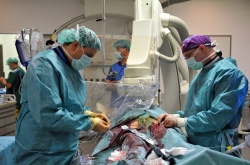Europe's inconsistent use of device therapy in the prevention of sudden cardiac death
Even though the use of implantable devices for the treatment of heart failure and heart rhythm disturbances has increased enormously in Europe in recent years, there still remain large differences between countries. Indeed, a report last year in the European Journal of Heart Failure found that there is an underuse of devices in many of the European countries surveyed.(1) This is especially so in the emerging economies of Eastern Europe.


Thus, while the use of device therapy - in particular the implantable cardioverter defibrillator (ICD) - has gained increasing acceptance and is now being used on a large scale as an adjunct to traditional drug treatment, there are still many patients at high risk of sudden death who are denied these anti-arrhythmic treatments because of limited availability and trained specialists.
These discrepancies among European countries - and building bridges to overcome them - are the subject of a two-day "summit meeting" in November at which representatives from countries with low, medium and high ICD use will explain the regional differences within their clinical, political and economic background.
The meeting, titled "Implantable Cardioverter Defibrillator (ICD) for Life Initiative - Fighting against Sudden Cardiac Death in Emerging Economies", will take place in Budapest on 26-27 November at the Hotel Zara.
"Overall in the emerging economies of ESC member countries," says Cardiologist Dr Christian Wolpert, from the University Hospital Mannheim, Germany, "we have found great disparity in access to anti-arrhythmic therapy, for a variety of reasons. The implant rates and number of treating centres and physicians certainly correlate with the economic status of their countries and budget restrictions. However, even in countries with a higher GDP and where device therapy could be implemented, we have found low awareness, a lack of information and few treating specialist, all of which leads to severe under-treatment. A higher uptake of device therapy could save many sudden cardiac deaths."
An analysis of ICD use in ESC member countries (published by the EHRA in the 2010 White Book)(2) shows a great difference in the number of implantations between the countries, says Dr Bela Merkely, President of the Hungarian Society of Cardiology. He adds: "It is likely that many patients who would potentially benefit from device therapy do not receive it. However, uptake does not just depend on budget, reimbursement and GDP. Implantation is a technically demanding task. Education in device therapy – concerning indications, device selection, programming and troubleshooting - and the implantation procedure must all be emphasised to increase the number of implantations."
Professor Béla Merkely, President of the Hungarian Society of Cardiology, says the meeting aims to build bridges between the medical, political and industrial sectors "so as to procure greater political and economic care for the prevention and treatment of sudden cardiac death, heart failure and arrhythmias".
"We are inviting representatives from countries with low, medium and high procedure numbers to highlight these regional differences and reflect their political and economical background - which is why we have the participation of Central and Eastern European cardiologists, health economists, politicians and journalists."
Because of this broad scope, the EHRA Summit is also supported by its main patron, Dr Pál Schmitt, President of the Hungarian Republic, and by Dr Miklós Réthelyi, the Minister of National Resources.
Dr Panos Vardas, President of the EHRA, says: "This summit meeting in Budapest is not about the technical details of electrophysiology but more about its everyday benefits in the prevention of sudden cardiac death. Sudden cardiac death is responsible for for a great number of deaths each year - and indeed in industrialised countries is the leading cause of death. Device therapy can correct many rhythm disturbances and reduce mortality rates. ICDs are expensive, but their cost-effectiveness is comparable to - even more favourable than - other more commonly used treatments."
23.11.2010











